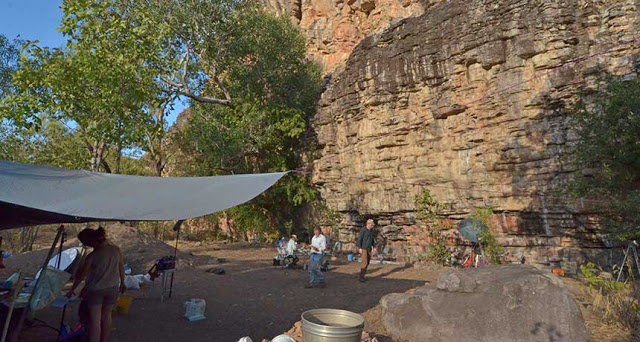The Madjedbebe rock shelter is the oldest-known site of human occupation in Australia. (Supplied: Gundjeihmi Aboriginal Corporation/Dominic O’Brien)
Archaeologists have found a series of tools which date back to around 65,000 years ago, pointing to the fact that humans already inhabited the continent long before the demise of the megafauna.
When the first humans left the African continent, they were skilled enough to reach the most remote corners of the planet.
An international team of scientists discovered a number of artifacts, including ochres and ancient axes, at a site in northern Australia, which indicates that humans reached Australian land about 65,000 years ago, more than 10,000 years earlier than previously thought.
This hypothesis not only replaces a chapter of humanity’s most significant diaspora but questions the theory that man was responsible for the extinction of the unique megafauna of the continent, such as the giant versions of kangaroos, wombats or Turtles, more than 45,000 years ago.
Experts uncovered three distinctive layers of artifacts at Madjedbebe, one of Australia’s oldest known sites of ancient human habitations during excavations that took place between 2012 and 2015.
The oldest and deepest layer excavated by experts yielded more than 10,000 relics of human handwork, including what is considered the ‘oldest’ polished ax heads, the continents oldest seed-grinding and intricate pigment-processing tools, sophisticated stone points which experts believe were used as spearheads and countless other artifacts that provide experts with an ocean of data about the everyday life of humans in Australia, 65,000 years ago.
“We were gobsmacked by the richness of material that we were finding at the site: fireplaces intact, a ring of grind stones around it, and there were human burials in their graves,” said Chris Clarkson, an archaeologist from the University of Queensland in Australia and lead author of the study.
“No one dreamed of a site so rich and so old in Australia.”
Peter Hiscock, an archaeologist at the University of Sydney who was not involved in the study commented the discovery saying:
“When people think about our ancient ancestors, they either tend to have a view that our ancestors must have been primitive, less culturally diverse, or they take the view that our ancestors were probably extraordinarily culturally impressive.
“This indicates the latter view. The moment people get to Australia, they’re doing all this brilliant stuff.”
The discovery changes the previous early estimates of human occupation in Australia—between 45,000 and 60,000 years ago—which was dated from artifacts found at the same site (Madjedbebe) in 1989.
Interestingly, all studies and excavations were supervised by the local Aboriginal community.
As it turns out, the Gundjeihmi Aboriginal Corporation, in charge of representing the Mirarr people, reviewed the findings thanks to a memorandum of understanding and a contract with the scientists, which gave the community the opportunity to supervise the excavation.
Aborigines were interested in learning more about the first human occupants, particularly after the environmental threats posed by today’s nearby mining activities.
After recovering the artifacts, the research team, led by experts from the University of Queensland, used a modern technique called optically stimulated luminous (OSL) to determine the age of the artifacts.
This and other cutting-edge techniques helped experts to establish the time in which the ancient Australians lived and how the surrounding environment looked at that time.
Scientists found that when ancient humans arrived, northern Australia was much wetter and colder.
Radiocarbon dating, a process which requires a certain level of carbon in a substance, can analyze organic materials up to 45,000 or 50,000 years.
But the OSL goes further and can date the last time a grain of sand was exposed to sunlight, which is useful in determining when an artifact was buried, up to 100,000 years ago or more.
In addition, the Madjedbebe vegetation remained stable during human occupation, suggesting that there was no major environmental change that could have led humans to leave the area.
Jean-Luc Schwenninger, the head of the Luminescence Dating Laboratory at the University of Oxford, said in an email that the team’s use of luminescence dating techniques provides a convincing case that humans came to Australia 65,000 years ago.
Must-read: The First Human Race Came From Australia, NOT Africa!
Sources: Ancient-Code.com; ScienceNews.org
Source Article from http://feedproxy.google.com/~r/HumansAreFree/~3/dhyNiuOZdac/changing-history-scientists-find-humans.html
Related posts:
Views: 0
 RSS Feed
RSS Feed

















 July 28th, 2017
July 28th, 2017  Awake Goy
Awake Goy 


 Posted in
Posted in  Tags:
Tags: 
















